Chapter 1: Characteristics of the Global Anabaptist Profile Conferences
By Conrad Kanagy
What characterized those who participated in the Global Anabaptist Profile? How many women? How many men? How rural and how urban are our churches? How old and how young? This chapter addresses these kinds of questions, summarizing the demographic profile of respondents in the Global Anabaptist Profile. We answer these questions by providing overviews at several levels—by comparing the Global North (Europe and North America) with the Global South (Africa, Asia, and Latin America); by comparing differences and similarities among the five continents; and, finally, by occasionally noting some distinctive characteristics of individual conferences.
Sex
Overall, respondents of the Global Anabaptist Profile were evenly split by sex (50% male and 50% female), with a similar distribution within the Global South (50% male and 50% female) and slightly more women in the Global North. Comparisons across continents and affiliations, however, revealed greater differences. Respondents were slightly more likely to be male in Africa (57%) and Asia (54%) and slightly more likely to be female in Latin America (61%) and Europe (56%). We learned from conversations with Research Associates that higher rates of participation among men in Africa (particularly in the Congo) likely resulted from lower levels of literacy among women. We also know from our Research Associates in Latin America that rates of church participation among women are much higher than among men, which our findings confirmed. We also noted some differences in sex by church affiliation, with Brethren in Christ (58%) and Mennonites (55%) more likely to be women as compared to Mennonite Brethren where more were men (62%).
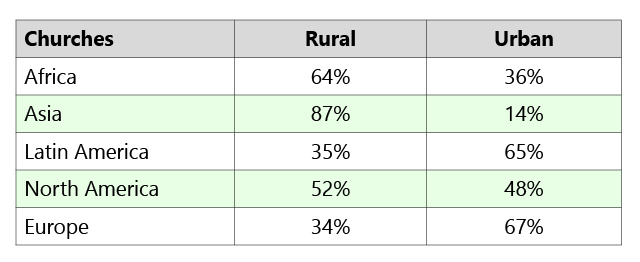
Residence
Anabaptist respondents in the Global Anabaptist Profile are more likely to live in rural areas (62%) than in urban (38%), with Global Southerners more rural (64%) compared to Global Northerners (49%). Nearly nine of ten Asians (87%) and nearly two-thirds of African Anabaptists (64%) live in rural communities. Europeans (67%) and Latin Americans (65%) are more likely to be urban, with North Americans about evenly split in terms of residential distribution. Members of all three Global Anabaptist Profile conferences were more likely to be rural than urban, but a higher percentage of Brethren in Christ (66%) and Mennonite Brethren (67%) members reside in rural communities than is true among Mennonite members (58%).
Economic status
The Global Anabaptist Profile survey asked participants to rank themselves in terms of wealth and income relative to others in their country. Sixty-nine percent of African respondents placed themselves in the lower 50 percent of their country, as compared to Asians (27%), North Americans (36%), Latin Americans (47%), and Europeans (57%). Forty-three percent of members in the Global South placed themselves within the bottom 50 percent of their country in terms of income as compared to 39% of those in the Global North. (At the July 2015 consultation, several Research Associates noted that some survey participants had difficulty understanding how to respond to this question, not knowing how their economic standing compared to that of others in their country.)
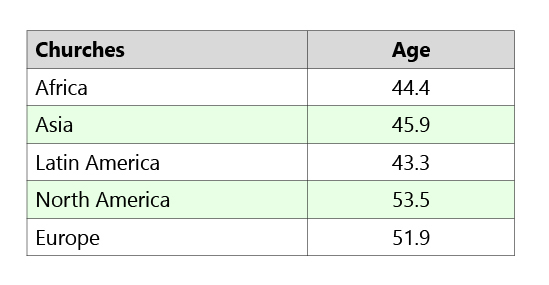
Age
The average respondent in the Global Anabaptist Profile was 46 years of age; the average age of members is 44 years in the Global South and 53 years in the Global North. Individual conferences, however, vary widely in their average age, ranging from 36 years of age among the Brethren in Christ Mpingo Wa Abale Mwa Kristu (Malawi) to 63 years of age among members of Arbeitsgemeinschaft Mennonitischer Gemeinden in Deutschland (Germany).
Important differences exist by continent as well. North Americans have the highest average age at 54 years, followed by Europe at 52 years. Church members in Latin America (43 years), Africa (44 years), and Asia (46 years) are nearly a decade younger on average than their northern counterparts. Results within conferences are less noticeable—Mennonite Brethren have the oldest members (48 years), followed by Brethren in Christ (47 years), and Mennonites who are about three years younger (45 years).
Average age is a good example of what we see throughout the Global Anabaptist Profile summary—continental or regional differences tend to outweigh affiliation differences in importance. This finding aligns with previous research, which has shown that affiliation differences and distinctives are less important in the Global South than they are in the Global North.
Members of childbearing age
The proportion of members still within childbearing age (18-45 years) is a significant consideration in terms of the overall trajectory of the global church. Churches in the Global Anabaptist Profile varied substantially on this point, from 84 percent among the Brethren in Christ of Malawi being 18-45 years of age as compared to 15 percent in Arbeitsgemeinschaft Mennonitischer Gemeinden in Deutschland (Germany).
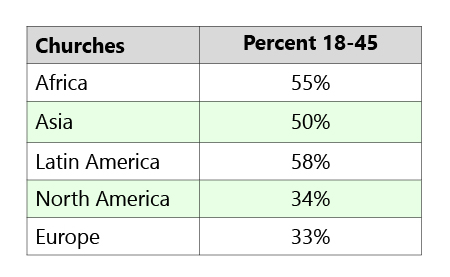
These two churches characterize an important difference between Global Anabaptist Profile churches in the Global South and those in the Global North: 54 percent of church members in the South are between 18-45 years of age, while in the North just 34 percent of members are within childbearing age. Latin America has the highest percentage of members within childbearing age (58%), followed by Africa (55%) and Asia (50%). North America and Europe are nearly identical at 34 percent and 33 percent, respectively.
Again, there were fewer differences by affiliation, with Mennonites having the highest proportion within childbearing age (54%) followed by the Brethren in Christ (49%) and the Mennonite Brethren (46%).
Educational levels
Substantial North/South differences exist in educational levels. According to the survey, 90 percent of those in North America and Europe were high school graduates as compared to 53 percent of MWC members in Africa, Asia, and Latin America. Within the Global South, 46 percent of African church members are high school graduates, compared with 58 percent of Asians, and 53 percent of Latin Americans. North Americans have the highest levels of education, with 93 percent being at least high school graduates followed by 78 percent of Europeans.
The lack of difference in educational levels by denominational affiliation (61 percent of Brethren in Christ are high school graduates; 62 percent of Mennonite Brethren; and 57 percent of Mennonites) likely contributes to the relatively small differences that we see in practice and belief by affiliation as compared to substantial differences by continent.
These findings, though not surprising, are nonetheless important since education is typically associated with upward mobility, affluence, power, and more rationalizing perspectives. Education helps to structure social and economic differences and also impacts theological differences. Sustained educational differences among Anabaptists by continent will likely continue to reinforce social and economic inequities in the global church as well as differences in theology and practice between hemispheres.
Year of conversion
Other scholars of global Christianity have clearly documented that the growth of the church in the Global South has come largely in the decades since the 1980s. Our findings in the Global Anabaptist Profile support these observations. Among all participants in the survey, nearly one-half became a Christian between 1991 and 2014 (47%), though there were substantial differences by conference and continent.
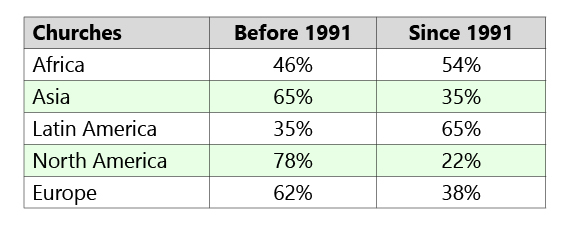
The greatest growth in the last several decades has come among the MWC churches of Latin America—with 65 percent of members there coming to Christ since 1991. This explosion of conversions is exemplified by the Organización Cristiana Amor Viviente of Honduras where 76 percent of its members have become Christians since 1991. This strong growth is also mirrored in the conferences of Nicaragua, Guatemala, Brazil, and Colombia— all with more than two-thirds of their members identifying as Christian since the 1990s.
The rapid growth of Latin America compares with 54 percent of African members who have converted to Christ since 1991, followed by 38 percent in Europe and 35 percent in Asia.
Only a small percentage of Anabaptists in North America, by contrast, became a Christian since 1991 (12%), ranging from 11 percent of Mennonite Brethren in the United States to 36 percent of respondents among the Evangelical Mennonite Church in Canada. European growth would be even slower than that of North America without the contribution of the Arbeitsgemeinschaft Mennonitischer Brüdergemeinden in Germany, among whom 46 percent have become Christian since 1991. Within the churches of the Arbeitsgemeinschaft Mennonitischer Gemeinden in Deutschland (Germany), only 7 percent of members became a Christian since 1991.
Of the three denominational affilations, 51 percent of Mennonite MWC members have become a Christian since 1991, followed by the Brethren in Christ (49%) and more distantly the Mennonite Brethren (40%).
The average year of conversion by continent is 1975 in North America, 1982 in Europe, 1984 in Asia, 1991 in Africa, and 1995 in Latin America.
These findings, and others that follow, clearly point to a trajectory of recent and rapid growth in MWC member churches in the Global South, while the relative membership of churches in North America and Europe is stagnant or in decline.
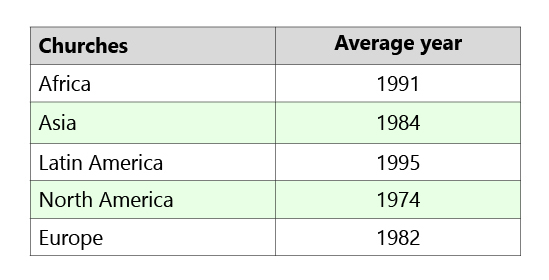
If we consider more recent growth since 2001, the North/South contrast among MWC churches becomes even sharper. In the Global South 27 percent of church members have come to Christ since 2001 compared to 10 percent of Global Northerners.
Once again Latin America has the most expansive growth—with 39 percent of members accepting Christ in the past 15 years. The Latin American conferences with the greatest recent growth are Organización Cristiana Amor Viviente of Honduras, (46%), Convención de Iglesias Evangélicas Menonitas de Nicaragua (49%), and Aliança Evangélica Menonita of Brazil (49%).
Africa has the second highest percentage of converts since 2001 (28%) with Mpingo Wa Abale Mwa Kristu of Malawi (49%), Grace Community Church in South Africa (43%), and BIC Ibandla Labazalwane kuKristu eZimbabwe (43%) leading the way.
Recent Christian conversions in Asia follow (14%), with the Integrated Mennonite Churches of the Philippines far ahead of the others (44%).
There has been little recent growth among North American and European churches. Among the three Global Anabaptist Profile denominational affiliations, the Mennonite Brethren stand out as the denomination with the lowest percentage of members who have come to Christ since 2001 (19%) as compared to Brethren in Christ (28%) and the Mennonites (26%).
Among all recent converts (2001 to the present) globally, 93 percent have been among churches in the Global South as compared to just 7 percent from the Global North. In other words, more than nine in ten converts since 2001 have been among churches of Asia, Africa, and Latin America.
To be sure, population growth has been greater in the Global South than in the Global North over the past several decades, which has affected conversion rates in both hemispheres. Demographic variables alone, however, are an insufficient explanation for the growth of Christianity in the Global South and its decline in North America. Populations have grown in both Europe and North America—in Europe from 721 million in 1990 to 735 million in 2010 and from 253 million in the United States in 1990 to 310 million in 2010 (United Nations, Department of Economic and Social Affairs, Population Division, 2015). In addition, demographics do not explain the nature of Christianity which is growing in the Global South—a more charismatic/Pentecostal variety than that of Christian faith in the Global North.
Age of conversion
The age at which a respondent became a Christian tells us something about the evangelistic activity of a church. Previous research suggests that the longer a church exists, the more it relies for growth upon internal conversions of its own children and youth. In these cases, the average age of conversion will be relatively young. Newer churches, by contrast, tend to be more active in attracting adult members from outside of the church; here the average age of conversion is likely to be older.
The average age of conversion among MWC churches is 19.0 years of age, with a great deal of variation across churches and continents. In North America the average age of conversion is 13.6. In Asia the average is slightly higher (16.3), and even higher in Europe (17.3), Africa (20.7), and Latin America (23.2). The high age of conversion in Latin American churches is consistent with the high rate of recent conversions there that we noted above.
Intergenerational church membership
To what extent did respondents to the survey attend the same MWC church as their parents? Among Global Anabaptist Profile respondents as a whole, 57 percent grew up in a home where one or both parents attended a congregation that was part of the same MWC-related conference (stated the other way around, 43 percent of MWC church members are first-generation attenders or members of their church). Somewhat surprisingly, more members were second-generation attenders in their churches in the Global South (61%) than in the Global North (38%).
MWC conferences with 50 percent or more of members who were at least second-generation attenders included:
- U.S. Conference of Mennonite Brethren of Churches (51%)
- BIC Mpingo Wa Abale Mwa Kristu of Malawi (52%)
- Bihar Mennonite Mandli in India (54%)
- Vereinigung der Mennoniten Brüder Gemeinden Paraguays (55%)
- Communauté des Églises des Frères Mennonites au Congo (61%)
- Arbeitsgemeinschaft Mennonitischer Gemeinden in Deutschland (61%)
- Communauté Mennonite au Congo (67%)
- Gereja Injili di Tanah Jawa of Indonesia (82%)
- Convención Evangélica Hermanos Menonitas Enlhet of Paraguay (89%)
- Conference of the Mennonite Brethren Churches of India (96%)
Within the five MWC regions, we would expect that continents with the greatest recent membership growth would have the lowest levels of intergenerational church attendance. This turned out to be partially true, but the results also revealed an interesting twist. As we might expect, Latin America had lowest percentage of intergenerational attenders (40%); Asia, with relatively low overall church growth had the highest number (82%), and Africa was between (55%) the two. The rates of intergenerational membership were much lower than we might expect in both Europe (45%) and North America (36%), although the European figures were heavily influenced by the recent growth of the Arbeitsgemeinschaft Mennonitischer Brüdergemeinden.
Lower rates of conversion in North American and European churches, accompanied by low rates of intergenerational church attendance, point to two simultaneous realities—MWC churches in the Global North are failing to evangelize new converts and failing to retain their young people.
Among the three Global Anabaptist Profile affiliations, the Mennonite Brethren have the highest rates of intergenerational membership (71%), followed by Mennonites (55%) and the Brethren in Christ (38%). In other words, nearly two-thirds of the Brethren in Christ are made up of more new members, as compared to just under one-half of Mennonites and less than one-third of Mennonite Brethren.






